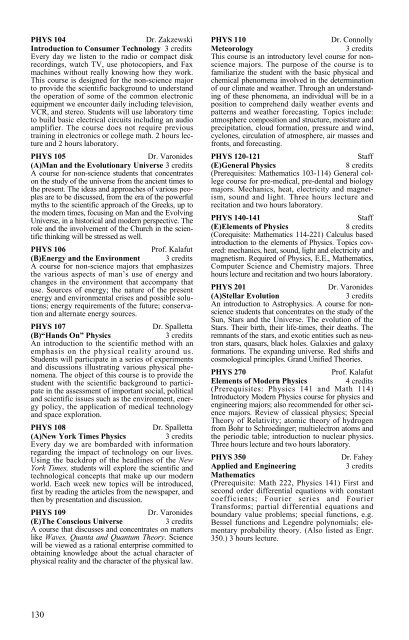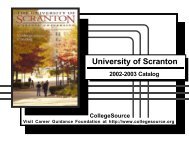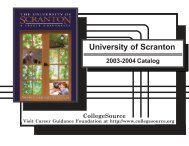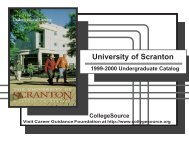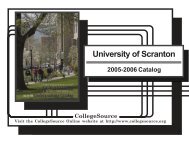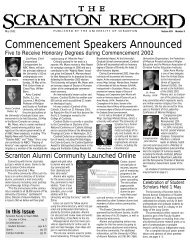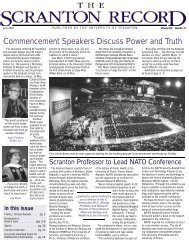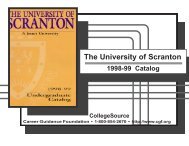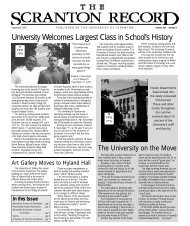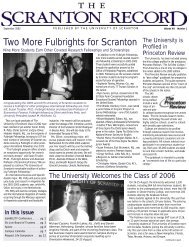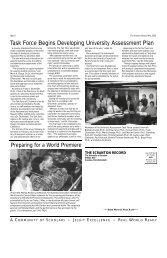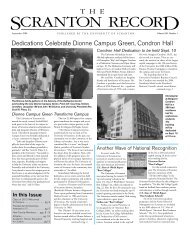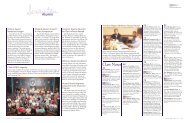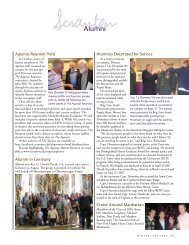Create successful ePaper yourself
Turn your PDF publications into a flip-book with our unique Google optimized e-Paper software.
PHYS 104 Dr. Zakzewski<br />
Introduction to Consumer Technology 3 credits<br />
Every day we listen to the radio or compact disk<br />
recordings, watch TV, use photocopiers, and Fax<br />
machines without really knowing how they work.<br />
This course is designed for the non-science major<br />
to provide the scientific background to understand<br />
the operation <strong>of</strong> some <strong>of</strong> the common electronic<br />
equipment we encounter daily including television,<br />
VCR, and stereo. Students will use laboratory time<br />
to build basic electrical circuits including an audio<br />
amplifier. <strong>The</strong> course does not require previous<br />
training in electronics or college math. 2 hours lecture<br />
and 2 hours laboratory.<br />
PHYS 105 Dr. Varonides<br />
(A)Man and the Evolutionary Universe 3 credits<br />
A course for non-science students that concentrates<br />
on the study <strong>of</strong> the universe from the ancient times to<br />
the present. <strong>The</strong> ideas and approaches <strong>of</strong> various peoples<br />
are to be discussed, from the era <strong>of</strong> the powerful<br />
myths to the scientific approach <strong>of</strong> the Greeks, up to<br />
the modern times, focusing on Man and the Evolving<br />
Universe, in a historical and modern perspective. <strong>The</strong><br />
role and the involvement <strong>of</strong> the Church in the scientific<br />
thinking will be stressed as well.<br />
PHYS 106 Pr<strong>of</strong>. Kalafut<br />
(B)Energy and the Environment 3 credits<br />
A course for non-science majors that emphasizes<br />
the various aspects <strong>of</strong> man’s use <strong>of</strong> energy and<br />
changes in the environment that accompany that<br />
use. Sources <strong>of</strong> energy; the nature <strong>of</strong> the present<br />
energy and environmental crises and possible solutions;<br />
energy requirements <strong>of</strong> the future; conservation<br />
and alternate energy sources.<br />
PHYS 107 Dr. Spalletta<br />
(B)“Hands On” Physics 3 credits<br />
An introduction to the scientific method with an<br />
emphasis on the physical reality around us.<br />
Students will participate in a series <strong>of</strong> experiments<br />
and discussions illustrating various physical phenomena.<br />
<strong>The</strong> object <strong>of</strong> this course is to provide the<br />
student with the scientific background to participate<br />
in the assessment <strong>of</strong> important social, political<br />
and scientific issues such as the environment, energy<br />
policy, the application <strong>of</strong> medical technology<br />
and space exploration.<br />
PHYS 108 Dr. Spalletta<br />
(A)New York Times Physics 3 credits<br />
Every day we are bombarded with information<br />
regarding the impact <strong>of</strong> technology on our lives.<br />
Using the backdrop <strong>of</strong> the headlines <strong>of</strong> the New<br />
York Times, students will explore the scientific and<br />
technological concepts that make up our modern<br />
world. Each week new topics will be introduced,<br />
first by reading the articles from the newspaper, and<br />
then by presentation and discussion.<br />
PHYS 109 Dr. Varonides<br />
(E)<strong>The</strong> Conscious Universe 3 credits<br />
A course that discusses and concentrates on matters<br />
like Waves, Quanta and Quantum <strong>The</strong>ory. Science<br />
will be viewed as a rational enterprise committed to<br />
obtaining knowledge about the actual character <strong>of</strong><br />
physical reality and the character <strong>of</strong> the physical law.<br />
130<br />
PHYS 110 Dr. Connolly<br />
Meteorology 3 credits<br />
This course is an introductory level course for nonscience<br />
majors. <strong>The</strong> purpose <strong>of</strong> the course is to<br />
familiarize the student with the basic physical and<br />
chemical phenomena involved in the determination<br />
<strong>of</strong> our climate and weather. Through an understanding<br />
<strong>of</strong> these phenomena, an individual will be in a<br />
position to comprehend daily weather events and<br />
patterns and weather forecasting. Topics include:<br />
atmosphere composition and structure, moisture and<br />
precipitation, cloud formation, pressure and wind,<br />
cyclones, circulation <strong>of</strong> atmosphere, air masses and<br />
fronts, and forecasting.<br />
PHYS 120-121 Staff<br />
(E)General Physics 8 credits<br />
(Prerequisites: Mathematics 103-114) General college<br />
course for pre-medical, pre-dental and biology<br />
majors. Mechanics, heat, electricity and magnetism,<br />
sound and light. Three hours lecture and<br />
recitation and two hours laboratory.<br />
PHYS 140-141 Staff<br />
(E)Elements <strong>of</strong> Physics 8 credits<br />
(Corequisite: Mathematics 114-221) Calculus based<br />
introduction to the elements <strong>of</strong> Physics. Topics covered:<br />
mechanics, heat, sound, light and electricity and<br />
magnetism. Required <strong>of</strong> Physics, E.E., Mathematics,<br />
Computer Science and Chemistry majors. Three<br />
hours lecture and recitation and two hours laboratory.<br />
PHYS 201 Dr. Varonides<br />
(A)Stellar Evolution 3 credits<br />
An introduction to Astrophysics. A course for nonscience<br />
students that concentrates on the study <strong>of</strong> the<br />
Sun, Stars and the Universe. <strong>The</strong> evolution <strong>of</strong> the<br />
Stars. <strong>The</strong>ir birth, their life-times, their deaths. <strong>The</strong><br />
remnants <strong>of</strong> the stars, and exotic entities such as neutron<br />
stars, quasars, black holes. Galaxies and galaxy<br />
formations. <strong>The</strong> expanding universe. Red shifts and<br />
cosmological principles. Grand Unified <strong>The</strong>ories.<br />
PHYS 270 Pr<strong>of</strong>. Kalafut<br />
Elements <strong>of</strong> Modern Physics 4 credits<br />
(Prerequisites: Physics 141 and Math 114)<br />
Introductory Modern Physics course for physics and<br />
engineering majors; also recommended for other science<br />
majors. Review <strong>of</strong> classical physics; Special<br />
<strong>The</strong>ory <strong>of</strong> Relativity; atomic theory <strong>of</strong> hydrogen<br />
from Bohr to Schroedinger; multielectron atoms and<br />
the periodic table; introduction to nuclear physics.<br />
Three hours lecture and two hours laboratory.<br />
PHYS 350 Dr. Fahey<br />
Applied and Engineering 3 credits<br />
Mathematics<br />
(Prerequisite: Math 222, Physics 141) First and<br />
second order differential equations with constant<br />
coefficients; Fourier series and Fourier<br />
Transforms; partial differential equations and<br />
boundary value problems; special functions, e.g.<br />
Bessel functions and Legendre polynomials; elementary<br />
probability theory. (Also listed as Engr.<br />
350.) 3 hours lecture.


